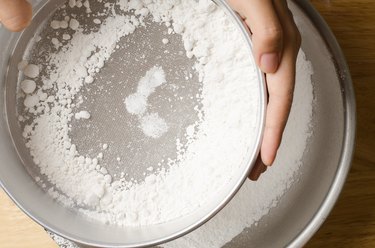
A quick read of your protein powder or baking flour's ingredient lists most likely reveals the ingredient silicon dioxide. While it's a common food additive, silicon dioxide is also added to cosmetics. But is it safe to eat or put on your face?
What Is Silicon Dioxide?
Video of the Day
Silicon dioxide, also known as silica, is a chemical compound commonly used in food as an anti-caking agent or in cosmetics to prevent corrosion, according to the USDA. Silicon dioxide helps keep the powders free-flowing and moisture-free and is a common additive in foods like flour, baking powder, sugar and salt, according to the Food and Drug Administration (FDA).
Video of the Day
While silicon dioxide is safe for consumption, it can be unnerving to hear that you may be eating the same additive used in your makeup. However, this compound is totally safe to use, according to the USDA. Without silicon dioxide, many of the foods you buy would begin to lump and clot due to moisture absorption.
Silicon Dioxide in Food and Supplements
"Like many other chemical terms that people think are harmful just because they're hard to pronounce, silicon dioxide sounds ominous," Bonnie Taub-Dix, RD, tells LIVESTRONG.com. "But it actually appears naturally in many foods including leafy greens, oats, bell peppers and beets."
When it comes to supplements, silica is also a common food additive found in many protein powders, according to Julie Upton, RD and co-founder of Appetite for Health. The compound prevents the whey and other protein powders from clumping over time.
Aside from its use in powdered foods, silica is also used as a stabilizer in the production of beer, according to the FDA. However, the additive is then filtered out of the alcohol in the final processing steps.
Silicon Dioxide Side Effects
Generally used in very small quantities, silicon dioxide is safe for consumption and there is little evidence that has shown adverse effects with food consumption, according to Upton. With that said, silica added to food can not exceed 2 percent of the food's total weight, as mandated by the FDA.
However, don't get the food additive confused with crystalline silica. Crystalline silica, a basic component of soil, sand, granite and other minerals commonly found on the Earth's surface, can prove dangerous with long-term exposure, according to the Occupational Safety and Health Administration (OSHA). Laborers that come in close contact with crystalline silica must take proper safety precautions when handling or working with the compound.
- USDA: "Silicon Dioxide"
- FDA: "Overview of Food Ingredients, Additives & Colors"
- FDA: "CFR - Code of Federal Regulations Title 21"
- Occupational Safety and Health Administration: "Crystalline Silica Exposure” Health Hazard Information for General Industry Employees"
- Drugs.com: Silicon Dioxide
- Select Committee on GRAS Substances (SCOGS) Opinion: Silicon dioxides